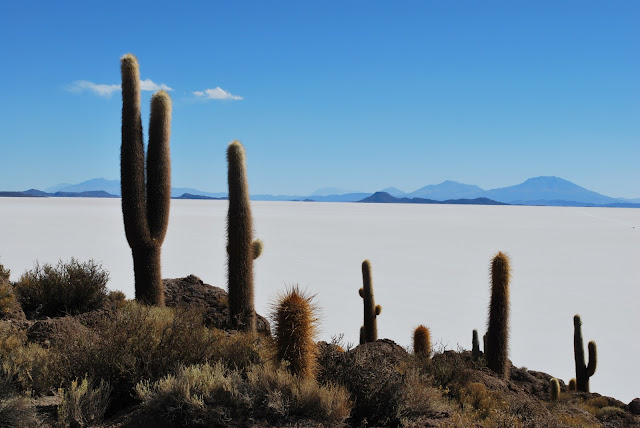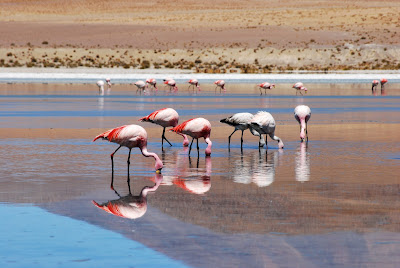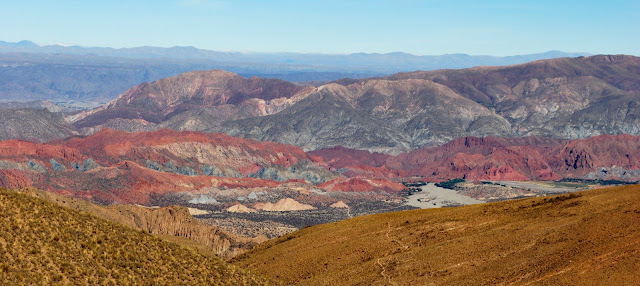We were hoping to get this post up tonight when we got to Cafayate, but after arriving at the bus station for our 3:00pm we found out it was actually a 5:00pm bus. We were bummed out until we found a power outlet and free wifi! As an added bonus terminals in Argentina are safe in comparison to any of the previous places we have been. There is even a pharmacy, which is handy as we have been passing back and forth a very inconvenient sinus cold.
After Sucre we headed back to Potosi and arranged a tour of a silver mine on Cerro Rico for the next morning. The tours are led by ex-miners and you visit working mines so you are able see the working conditions in the mines. We were told that conditions haven't changed much in the past 400 years. Initially we were hesitant to go into the mines for a few reasons. Our guide book didn't fail to point out all the dangers and unpleasantries of the mines. After spending some time in Potosi, watching a documentary (The Devil's Miner), talking to other travellers, and Dewey's persistance we figured it would be an experience we couldn't miss.
We "suited up" (protective suits, boots, hard hats, and lamps) and took a micro bus up to the Miner's Market. There we were instructed to buy gifts for the miners; dynamite, nitroglycerin, fuses, and detonators. Potosi is one of the only places in the world where anyone can buy dynamite legally, on the street without a license. Other gifts included; coca leaves, chewable alkali, 96% pure alcohol, unfiltered cigarettes, and juice. The miners chew up to a bag of coca leaves a day while in the mines to as it supposedly works to fight hunger, filter dust, and maintain alertness. The alkali help release the alkaloids from the coca leaves. The alcohol is used both as an intoxicant and as an offering to El Tio (the God of the mines). Lisa had a problem with buying cigarettes and alcohol for the miners so we bought dynamite, juice, and coca instead. You had to buy at least some of these items in order to go on the mine tour and throughout the tour we handed these out to working miners that we passed in the tunnels.
We were invited to take a sip of the 96% alcohol. Alex decided to give it a try and it basically evaporated (probably for the better) upon contact. Note the Canada Dry label above!?
The miners don't work on salary, so their earnings depend on what minerals they can find and their quality. They are responsible for buying all of their own supplies and as a result our gifts of dynamite were greatly appreciated. We were also told that theft is very prevelant in the mines and often miners will find themselves working for a week just to afford new equipment.
The trolley below weights around 1 tonne and the two miners in the back are the man power and the miner in the front steers.
According to our guide book, "Work is done mostly by hand with basic tools, and underground tmeratures vary from below freezing to a stifling 45 degrees Celcius. Miners, exposed to myriad noxious chemicals, often die of silicosis pneumonia within 10 years of entering the mines". Unfortunately, over 800 children (mostly from families without a father) still work in the mines. Women are not allowed to work in the mines as it is cosidered bad luck, but many women are employed to guard the tools outside the mines. The walls of the tunnels were covered with asbestos and arsenic. When we asked our guide why the miners don't wear masks he said that chewing coca and smoking cigarettes prevents the toxins from entering the miners lungs (??).
The miners believe that God can't help them in the mines and therefore they worship El Tio. There is at least one Tio in each mine and hundered of independent mines tunnel through the mountain. Mines often stretch for around 14km and can have as many as 16 levels. The mines often intersect each other if they are following the same mineral vein. Miners feel obligated to make generous offering to El Tio to keep them safe while they are in the mines. You can see coca leaves, cigarettes, and full alcohol bottles scattered around El Tio. Worshiping El Tio is believed to aid fertility.
The quality of the photos is poor since the tunnels were dark and dusty and it would have been foolish to bring the Nikon. We thought a good alternative was Lisa's drop-proof, water-proof, point and shoot. We were in the mines for about two hours and explored the first three levels. To change levels you had to descend ladders through steep dark holes. Our guide cautioned us not to wiggle the ladders too much or look up since falling rocks were not uncommon. At one point one of the miners set off some dynamite on the path that was also our only exit and we waited around the corner for the blast. You could definitely feel it!
This video is of us squeezing (literally) through a small hole between levels. There is only one exit to the mine, so everywhere we went down we knew were coming back up.
Overall, the whole experience (while it may not have been comfortable) was very eye-opening and educational. We will definitely think twice before complaing about work conditions in Canada.















































































